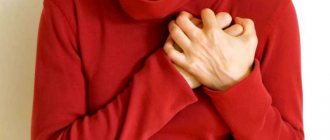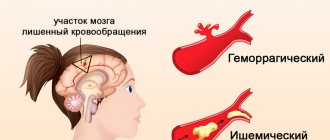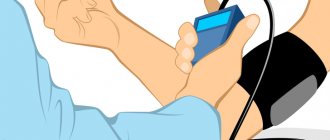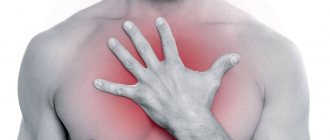If a person experiences pain in the heart and has trouble breathing, this is a sign of the presence of pathology. First of all, the patient should be given emergency care, and then a full diagnosis and a cardiologist should be carried out. Therapy should be prescribed only after determining the exact cause of the condition.
Causes of pain in the heart due to difficulty breathing
Pain in the heart and difficulty breathing - these symptoms may be a sign of pathologies of the heart and vascular system. Often, a similar clinical picture occurs in people who have an absolutely healthy heart. In this case, the symptom may indicate the presence of disorders in the nervous system.
Experts identify a number of the most possible diseases that can provoke heart pain and difficulty breathing. An accurate diagnosis can only be established through a complete examination.
IHD
When there is pain in the heart and difficulty breathing, this phenomenon is characterized by a decrease in local blood circulation, which provokes cardiac dysfunction or permanent damage. The disease is accompanied by damage to the coronary arteries, resulting in impaired blood circulation in the myocardium.
In addition to pain in the heart and difficulty breathing, the disease is also characterized by the following symptoms:
- Swelling of the lower extremities.
- Feeling of rhythm disturbance.
- Interruptions in the activity of the heart.
- Weakness.
Most often, heart pain with IHD (coronary heart disease) develops after stress or physical activity. Ischemia is a pathological condition that may indicate the presence of many diseases. Among them are coronary death, cardiosclerosis, angina pectoris and heart attack.
Myocardial ischemia
Develops against the background of functional and organic damage to the myocardium. It occurs as a result of a disruption in the blood supply to the heart muscle. Manifests itself in both acute and chronic forms. In the first case, the patient faces cardiac arrest, in the second - angina pectoris, which is characterized by severe pain in the sternum and heart failure. According to statistics, ischemic disease is one of the most common causes of sudden death.
Heart attack
If a person has pain in the heart and has difficulty breathing, this may indicate a myocardial infarction.
This form of ischemia presupposes the presence of insufficient blood supply in a certain area of the myocardium, as a result of which the development of ischemic necrosis is observed in it.
In this condition, the pain in the heart is angiotic in nature. It can radiate to other areas: arm, shoulder blade, stomach, throat. Moreover, the use of nitroglycerin does not eliminate this symptom.
Difficulty breathing is an atypical feature of this condition, as is shortness of breath. The classic symptoms of a heart attack are considered to be the appearance of cold sweat, pale skin, and fainting.
Breathing disorders are characteristic of the asthmatic variant of a heart attack, which is an atypical form of pathology. The pain in this case is usually mild. Patients may experience a dry cough, accompanied by foamy sputum, and suffocation. This form is characteristic of recurrent infarction and can provoke pulmonary edema.
When do you still experience pain in the heart area and difficulty breathing?
Chest pain
Any pain signals a malfunction in the body. There are many causes of chest discomfort. To thoroughly understand the problem, it is necessary to determine which side puts more pressure on the chest. The disease is often accompanied by various accompanying symptoms - a dry cough or with phlegm, it becomes difficult to breathe, there is not enough air, a lump appears in the throat. Often the discomfort increases with breathing and movement.
Pain in the central part of the chest is a consequence of heart problems; it intensifies with the slightest physical exertion. At rest, breathing becomes easier, nothing compresses the chest. In addition to difficulty breathing, there is increased sweating, shortness of breath, and nausea.
Discomfort in the middle of the chest often occurs in smokers, hypertensive patients, diabetics, and overweight people. A severe cough with phlegm can provoke an attack of pain.
If the chest is compressed for more than 20 minutes, the discomfort is accompanied by severe pain - these are signs of a heart attack. Urgent hospitalization is required.
Causes of discomfort in the sternum on the right or left:
- stress;
- muscle injuries;
- heartburn – the patient’s condition worsens in a horizontal position;
- pleurisy – the patient has difficulty breathing, inhalation is painful, the person is tormented by a cough;
- lichen caused by the herpes virus - characterized by a rash that appears on the right or left side of the body;
- mastitis - an inflammatory process from the mammary gland that spreads throughout the chest.
Discomfort in the chest on the right often occurs against the background of osteochondrosis, prolonged sitting, Tietze syndrome (when pressing on the ribs, the pain radiates to the chest area).
For any severe pain that is localized in the left side of the chest, you should consult a doctor. Also, medical help is required if discomfort often occurs on the right side, the pain intensifies with inhalation and movement, and is accompanied by a constant lack of air.
A simple exercise will help improve the oxygen supply to the body and make breathing easier. You need to lie down on a flat, hard surface with your hands clasped behind your head. At the same time, the lungs and chest expand, and more oxygen enters the body. When you perform the exercise daily for at least 40 minutes, fatigue goes away, blood pressure normalizes, headaches go away, and the constant feeling of lack of air subsides.
Pulmonary embolism
This disease is also a cardiovascular pathology. With this disease, the pulmonary artery and its branches become clogged with a thrombus. The source of the thrombus is most often a large vein located in the lower limb or pelvis.
Respiratory disturbance in such situations is expressed in the form of shortness of breath. The patient develops a cough, which at the initial stages is dry in nature, and subsequently accompanied by the release of sputum streaked with blood. It is possible that hemoptysis may occur.
Chest pain due to thromboembolism is usually worsened by coughing or deep breathing. In addition to these, the pathology may be accompanied by other symptoms:
- Cyanosis (manifests on the skin of the upper half of the body and face).
- Pallor.
- Fever.
- A sharp drop in blood pressure.
- Fainting state.
- Dizziness.
- Sharp weakness.
A person often has pain in the area of the heart and has difficulty breathing with cardiac asthma.
Causes of the symptom
Heaviness in the heart area can be caused by damage to the intervertebral discs of the thoracic region. The disease leads to a decrease in the height of part of the spine, as a result of which nerve endings are pinched. This condition is accompanied by aching or sharp pain behind the sternum, the intensity of which increases after increased stress and radiates to the arms. This pathology also causes intercostal neuralgia. Osteochondrosis leads to damage to the nerve endings located in the ribs. Discomfort increases with body movements. Respiratory failure is associated with the inability to expand the chest when inhaling.
The most common pathology of the digestive system, manifested in the form of chest pain, is gastroesophageal reflux - the penetration of stomach contents into the lower parts of the esophagus. Pain is usually observed after eating. The severity is caused by spasm of the skeletal muscles of the esophagus. Breathing difficulties are associated with the close location of the trachea. No less common diseases of the gastrointestinal tract are gastritis and stomach ulcers. These pathologies are characterized by an increase in the acidity of gastric contents that is not associated with food intake. Gas accumulates in the stomach, which leads to an increase in size of the organ. It compresses the diaphragm, which causes heaviness behind the sternum.
We recommend: Symptoms, treatment and consequences of heart contusion
Pulmonary embolism is a life-threatening condition in which a detached blood clot blocks the lumen of a large artery. There is a strong pressing pain behind the sternum. The patient needs emergency medical attention. Difficulty breathing often accompanies panic attacks. Other signs of this condition are tachycardia, muscle spasms, and an unreasonable feeling of fear.
Cardiac asthma
This pathological condition is often accompanied by suffocation and shortness of breath. Attacks of the disease are provoked by the formation of stagnation of blood in the veins of the lungs. The reason for this is disturbances in the functioning of the left heart.
An attack of pathology develops after stress or physical exertion. There is also an increase in blood flow to the lungs at night.
Many people don’t understand why their heart hurts and it’s hard to breathe.
Cardiac asthma is accompanied by shortness of breath, expressed in the form of difficult and prolonged exhalation. As a result of the narrowing of the lumen of the bronchioles, a sufficient volume of air does not enter the lungs. The patient has difficulty breathing and speaking.
During an attack, swelling of the mucous membranes in the bronchi begins, to which the body begins to react with the appearance of a suffocating cough. At the initial stages it is dry in nature, then the separation of clear sputum begins. Its volume may increase, and there is a risk of blood appearing in it.
An attack of cardiac asthma is accompanied by an acceleration of the heartbeat, which provokes chest pain. In addition, there are other symptoms:
- Profuse cold sweat.
- The patient develops a fear of death.
- Excitation.
- Cyanosis of the lips and phalanges of the fingers.
- Pallor of the skin.
What else could the symptoms mean when you have a headache, difficulty breathing and heart pain?
general characteristics
When they talk about pressure in the chest, they most often mean a feeling of constriction and squeezing, which can occur on the left or right of the sternum, or in the middle. The symptom may be accompanied by a burning sensation, sharp or dull pain, tingling, and difficulty breathing. Severe dull pain can radiate to the interscapular area, forearm, collarbone and neck.
Along with the feeling of squeezing, the patient may experience other signs, for example:
- pale skin (sometimes mucous membranes);
- burning, stinging and tingling in the chest area;
- slight increase in temperature (up to 37.2-37.3°);
- attack of asphyxia (suffocation);
- cramps of the calf muscles;
- pain in the back, lower back and tailbone area;
- fluctuations in blood pressure.
Note! The listed symptoms do not always appear. The clinical manifestations of the pathology depend on the cause that caused its occurrence. For example, with heart problems, the patient often experiences pathological pallor of the skin and difficulty breathing. In diseases of a neurological nature, involuntary muscle contractions (cramps) and shooting pain in the lower back, neck or forearm are common symptoms.
Chest pressure can also be acute or chronic. A one-time attack is most often not associated with any disorders and occurs under the influence of negative factors, which include:
- increased physical activity;
- emotional excitement and stress;
- lifting heavy objects;
- long stay in a stuffy, poorly ventilated room;
- sudden change in climatic conditions.
If attacks of pressure in the sternum, accompanied by difficulty breathing, appear periodically, it is important to identify the cause, since there may be serious disturbances in the functioning of vital organs.
Heart failure
This syndrome develops if the patient has a decompensated disorder in myocardial activity. This pathology is characterized by inadequate blood flow, resulting in hypoxia of tissues and organs.
The main manifestation of heart failure is shortness of breath. As a rule, it occurs during physical activity. An increase in pressure in the pulmonary vessels is possible. This phenomenon is accompanied by the appearance of a cough with the release of a certain amount of blood. At the same time, the heart hurts, it’s hard to breathe and the hand goes numb.
Discomfort in the chest develops as a result of increased heart rate, which can be triggered by eating a lot of food, lying down, or physical activity. The patient becomes weak and gets tired quickly. In the case where pain and a feeling of heaviness are localized in the hypochondrium on the right, it can be assumed that there is stagnation of blood in the hepatic vessels.
Symptoms of heart failure can develop over time even at rest. The following symptoms occur no less rarely:
- Cyanosis.
- Evening swelling of the legs.
- Frequent urge to urinate during sleep.
- Reducing the amount of urine excreted.
The main danger of heart failure is the likelihood of impaired blood circulation in the brain.
So, a person has a heartache, it’s hard to breathe, what should you do?
Etiology of pain formation
The overwhelming majority of patients who turn to a cardiologist with complaints of colitis in the heart and shortness of breath appear, are surprised to learn that their heart is healthy, but their nervous system has failed. The general practitioner advises contacting a neurologist. He concludes that the culprit of the sensitive tingling in the heart, which intensifies when trying to take a deep breath, is intercostal neuralgia. If preventive measures are taken in time, the problem can be easily resolved. If allowed, the disease develops and can lead to serious complications, including death. The mechanism of formation of intercostal neuralgia depends on the anatomical location of nerve receptors in the chest, which are more sensitive on the left side near the heart. With the development of an inflammatory process in them, any attempt to inhale or make a sudden movement causes apparent heart pain.
The variant of events in which heaviness in the heart area is actually associated with the organ itself provides for more serious symptoms. In addition to pain and difficulty breathing, a person may experience the following ailments:
- signs of strangulation;
- sharp fluctuations in heart rate, as a result the pulse either rises sharply or falls sharply;
- a significant increase in blood pressure is possible;
- It is difficult for a person to perform basic physical actions.
Most often, such symptoms are characteristic of the age group of patients. In young people, pathology develops as a result of organic disturbances in the functioning of the heart or traumatic injuries.
Doctors explain the appearance of disorders in the functioning of the heart muscle for a number of reasons:
- 1. Over the years, a person experiences a change in the nature of blood flow and the properties of blood flowing in the vessels. Hemodynamic parameters: flow rate and pressure gradient between sections of the channel in the vessels are closely related to the rheological qualities of the liquid: electrolyte composition, characteristics of red blood cells, plasma, proteins.
- 2. There is depletion of cardiac fibers and thinning of the walls of blood vessels.
- 3. The conductivity of nerve endings is disrupted.
The patient is urgently prescribed 24-hour monitoring, angiography, and an electric bicycle ergometer.
Urgent Care
A painful sensation in the heart, accompanied by difficulty breathing, indicates the presence of various pathologies. If such a symptom occurs, a person, first of all, should not be nervous.
If symptoms are severe or persist for a long time, you should call for medical help as soon as possible. While waiting for her, it is important to take the following measures:
- The person should take the most comfortable sitting position. If the patient takes a lying position, breathing may become even more difficult.
- It is necessary to take the recommended dose of Corvalol. This medication has a calming effect.
- It is necessary to take sublingual nitroglycerin. It will relieve chest pain and relax smooth muscle tissue.
- If symptoms of a heart attack are present, the patient should take aspirin. The tablet should be crushed and washed down with a small amount of water.
- It is necessary to measure pulse and, if possible, blood pressure. If it increases, it is recommended to take a normalizing medication. Antispasmodic drugs are most often available.
These actions must be agreed with your doctor. When contacting an ambulance, it is important to describe in detail the symptoms that have arisen.
Causes of the pathological condition
The heart is a hollow muscular organ located in the chest. The muscle fibers of the heart contract rhythmically - these contractions can be felt as a heartbeat or pulse. Heart function is important for blood circulation. The heart pumps blood throughout the body, supplying all organs and tissues.
If there is a pressing pain in the area of the heart, this often indicates a heart attack. However, such chest pain is often not heart pain, but has a cause in the lungs, diaphragm, or stomach discomfort.
Typical pressing pain in the heart area - angina pectoris - occurs with coronary heart disease. Victims complain of pain, pressure and a burning sensation in the chest, which is usually caused by physical or mental stress. The pain may radiate to the right or left arm, shoulders, neck, or cheeks and teeth. Heart pain due to coronary artery disease can also be associated with very atypical complaints.
An attack of angina usually lasts only a few minutes and can be stopped with nitroglycerin spray or capsules, which many patients with CAD use as an emergency medicine. If there is no improvement despite nitro medications, this may indicate a heart attack.
Behind the sensation of pain there can be both discomfort and heart disease. But not all pain in the sternum hides a heart defect. It is often stated that heart pain is associated with muscle tension, diaphragmatic tension, spinal and joint discomfort, which spreads as chest pain.
Some esophageal diseases (such as reflux disease) and stomach discomfort such as gastritis and lung diseases (such as pneumonia, pulmonary embolism) can cause pain similar to heart pain.
If no physical cause is found for heart pain, but the person still suffers from severe discomfort and is very afraid of a heart attack, this may also be an act of cardiac neurosis. There are some cardiovascular diseases that cause heart pain. Such pain should always be taken very seriously, especially if you have a known heart condition.
Dangerous causes of cardialgia:
- coronary heart disease (CHD) with angina pectoris;
- heart attack;
- endocarditis;
- pericarditis;
- myocarditis;
- heart valve disease;
- arrhythmia;
- heart failure;
- circulatory diseases such as high blood pressure;
- aortic aneurysm.
Pericarditis can cause pressure in the area of the heart.
Very often, heartburn causes chest pain. Often, a gastric inlet defect is responsible for the release of stomach acid into the esophagus. Another cause of heartburn is also an unhealthy diet. Avoiding heavy foods, spicy spices and acidifying substances such as alcohol and nicotine may already solve the problem.
Seeing a doctor
If chest pain occurs along with difficulty breathing, patients usually seek advice from a cardiologist, but the cause of the symptoms may lie not only in disorders of the cardiovascular system. Therefore, it would be more advisable to contact a therapist, who will analyze the manifestations of the disease and advise which specialist should be contacted.
Even if the unpleasant symptoms were managed at home, seeing a doctor is mandatory.
Are you sure your heart hurts?
Have you been trying to heal your JOINTS for many years?
Head of the Institute for the Treatment of Joints: “You will be amazed at how easy it is to cure your joints by taking the product for 147 rubles every day.
The most frequently asked question by a cardiologist—are you sure that it is your heart that hurts—is not without reason.
Our readers successfully use Sustalaif to treat joints. Seeing how popular this product is, we decided to bring it to your attention. Read more here...
After all, pain in osteochondrosis, myalgia or neuralgia, disorders in the digestive system, or pulmonary pathologies can be mistaken for heart pain.
As a rule, questions from the attending physician and thorough diagnostic procedures help to understand the nature of the pain.










